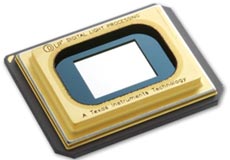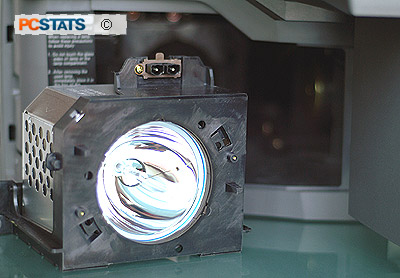 Digital Light Processing (DLP) is a product of the
Texas Instruments laboratories, and
is still fresh technology. The system was first used in digital theatre
projectors, and has recently been finding its way into television sets over the
last couple of years. Technically, televisions that use this technology are rear
projection displays, in that light is passed through or reflected from a device
that creates the picture before being cast onto the rear of the screen. In
reality, DLP TVs are vastly different from any preceding projection methods.
Digital Light Processing (DLP) is a product of the
Texas Instruments laboratories, and
is still fresh technology. The system was first used in digital theatre
projectors, and has recently been finding its way into television sets over the
last couple of years. Technically, televisions that use this technology are rear
projection displays, in that light is passed through or reflected from a device
that creates the picture before being cast onto the rear of the screen. In
reality, DLP TVs are vastly different from any preceding projection methods.
A DLP HDTV contains one or
more DMD (Digital Multi-mirror Device) chips as pictured here at right. These
are solid-state microchips covered with an array of millions of tiny mirrors
which move in response to the signal received by the chip. Light is shone onto
the DMD from a projection lamp, and by varying the amount of light reflected by
each micro-mirror, or blocking it, the chip can reflect a precise image onto the
screen composed of up to 1024 shades of gray.
To generate the colour, the
light from the lamp is passed through a rotating colour wheel before striking
the chip. This produces a colour image on the screen with a colour density of up
to 16 million shades. Since the colour comes from a single light source,
convergence is a non-issue with this display technology.
A single DMD chip can produce
more than 16 million colours, and systems with multiple chips are able to
project far more by separating each primary colour - but as of yet, multi-DMD
home systems are few and far between, and incredibly expensive. Future
enhancements to the DLP system will bring more resolution and colours to single
chip systems if the momentum for this technology remains constant.
 DLP Consumables
DLP Consumables
Like other projection
technologies, DLP sets do not suffer from the screen burn-in and fading issues
that can plague big-screen plasma and CRT TVs.
While plasma screens have
reported life spans of about three years, a DLP HDTV uses a projection lamp
which will require replacement eventually. According to the manufacturer, lamp
life should run in the 4000-8000 hour range, or 3+ years of normal use. A new
lamp will run you around $200-$300 USD, which is certainly a lot less than
replacing the entire screen as can be the case with a plasma TV.
The HLN617W is also
user-serviceable in this regard. The manual includes detailed instructions for
changing the lamp. As for whether the lamp's quality will deteriorate over time,
opinions are mixed. Personally we can't see how it would, being that it is
simply a high-end light bulb. The Samsung web site is of the same opinion.
The HLN617W's manual,
on the other hand, states that "the lamp used in a projection TV has a
limited life-span. For the best screen quality it needs to be replaced
periodically" which sounds a little more ominous.
Rainbow Effects
If DLP has any disadvantages,
it is the 'rainbow effect,' a visual appearance of colour breakup. This is an
optical illusion created by the sequential updating of the colours on the screen
by the rapidly rotating colour wheel. It can cause flashes of rainbow light in
your peripheral vision when you switch your focus to a different part of the
screen.
The effect is generally only noticeable in high-contrast
scenes, and then only when you are looking for it. If you are aware of it
though, it can become quite distracting. Some people are much more sensitive to
the effect than others, but it is worth noting that this effect is not
brought about by rapidly moving
images on the screen itself - only when the user looks around the screen real
estate rapidly. We'll talk about how the HLN617W performs in this regard in
little later in the review.
